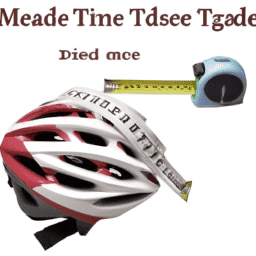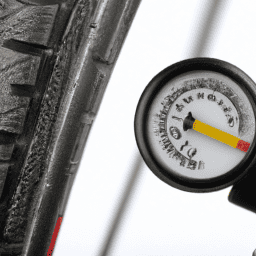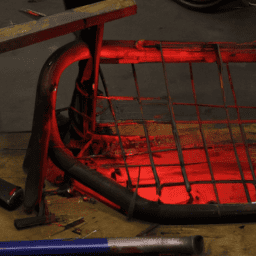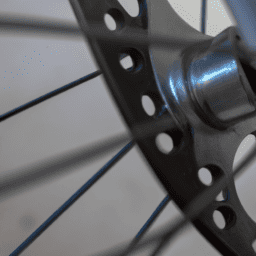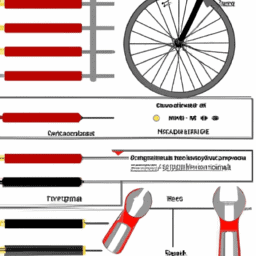As someone who cycles regularly, I am always aware of how critical it is to wear a helmet that fits correctly. It’s impossible to know when an accident might happen, but having a helmet on can greatly lessen the chance of sustaining a head injury. Yet, it’s important to note that helmets vary in quality, and securing one that fits well and is the right size is key for optimal safety.
In this article, I will share with you the steps to properly measure for a bicycle helmet. Before we begin, let me allude to the fact that measuring for a helmet is not a one-size-fits-all process. Each person’s head is unique, and finding the right fit requires careful attention to detail.
It is important to gather the necessary tools and equipment, find your starting point, take accurate measurements, determine your helmet size, and finally, try on helmets in person. So, let’s get started!
Key Takeaways
- Measuring for a helmet is a necessary process for ensuring proper fit and maximum protection while cycling.
- Proper equipment, including a tape measure and the helmet itself, is necessary for accurate measurements.
- Consult the manufacturer’s size chart and consider head shape when determining helmet size.
- Trying on helmets in person is crucial for ensuring proper fit and comfort, as not all helmets are created equal.
Gather Necessary Tools and Equipment
Before you start measuring, make sure you’ve got all the gear you need! The first thing you’ll need is a soft tape measure, which is flexible and easy to use. It’s important that the tape measure is long enough to wrap around your head, so make sure it’s at least 60 inches long.
You’ll also need a mirror or someone to help you measure, as it can be difficult to get a precise measurement on your own. Finally, make sure you have a helmet that fits properly and is in good condition. A helmet that’s too small or damaged won’t provide the necessary protection in case of an accident.
When it comes to measuring technique, start by placing the tape measure about an inch above your eyebrows and wrapping it around the widest part of your head. Make sure the tape measure is level, not too loose or too tight, and sits just above your ears. Keep the tape measure snug against your head, but not so tight that it’s uncomfortable.
Once you have a measurement, double-check it to make sure it’s accurate. It’s also important to regularly check and maintain your equipment, including your tape measure and helmet. Make sure your tape measure isn’t stretched out or damaged, and that your helmet isn’t cracked or worn out.
With the right equipment and proper measuring technique, you’ll be able to find your starting point for choosing the right helmet size.
Find Your Starting Point
Start your journey towards safety by pinpointing where you stand, because knowing your starting point is like taking the first step towards a brighter future.
Before taking any measurements, it’s important to understand the measuring technique to ensure that you get an accurate result. One common mistake people make is measuring the circumference of their head at the wrong spot. To avoid this, follow these tips:
- Make sure you’re wearing your hair how you usually would when riding your bike.
- Find the widest part of your head, which is usually about an inch above your eyebrows.
- If you have trouble finding this spot, try using a mirror or asking someone for help.
Once you’ve located the correct starting point, you can move on to taking accurate measurements.
Take Accurate Measurements
Now that you’ve found the widest part of your head, it’s time to get precise measurements for your bike helmet. To measure your head accurately, you’ll need a soft measuring tape.
Wrap the tape around your head, just above your eyebrows and ears. Make sure the tape is level and snug, but not too tight. Take note of the measurement in centimeters or inches.
Repeat this step two more times, taking measurements from different angles and making sure the tape is level and snug each time.
Measuring technique is crucial to ensure a proper fit for your helmet. Common mistakes include using a tape measure that is too thick or too tight, which can lead to an inaccurate measurement. Another mistake is measuring too high or too low on the head.
Measuring multiple times from different angles can help prevent these errors. Once you have your measurements, you can move on to determining your helmet size by consulting the manufacturer’s size chart.
Determine Your Helmet Size
To get the right fit for you, it’s important to consult the manufacturer’s size chart and pick the appropriate size based on your head measurements. Keep in mind that each brand may have different sizing, with some offering more options for smaller or larger heads. A common mistake people make is choosing a helmet that is too large, thinking it will be more comfortable. However, a loose helmet will not provide adequate protection in the event of an accident. On the other hand, a helmet that is too tight can cause discomfort and headaches.
To determine your helmet size, measure the circumference of your head above your eyebrows and ears, using a soft measuring tape. Then, compare your measurement to the manufacturer’s size chart. If your measurement falls between two sizes, go with the smaller size for a snugger fit. Additionally, consider the shape of your head when choosing a helmet. Some brands offer helmets that are more rounded, while others are more oval-shaped. Trying on helmets in person can help you determine which shape works best for you. So, before making a purchase, follow these helmet fit tips and consult the manufacturer’s size chart to ensure you choose the correct size and shape for your head.
Try on Helmets in Person
Make sure you experience the perfect fit and get the best protection for your head by trying on helmets in person. Don’t miss out on the opportunity to ensure your safety while feeling comfortable and confident on your rides.
Trying on a helmet in person provides several benefits that cannot be achieved by simply measuring your head size. One of the most important benefits of trying on helmets in person is the ability to ensure that the helmet fits properly. A helmet that is too loose or too tight can compromise its effectiveness in protecting your head.
Additionally, trying on a helmet in person allows you to assess its comfort level and adjust the fit accordingly. Remember, a helmet that is uncomfortable to wear may discourage you from wearing it, so it’s crucial to find one that is both safe and comfortable.
Overall, taking the time to try on helmets in person is a necessary step in ensuring that you have the best possible protection for your head while cycling.
Frequently Asked Questions
What is the ideal weight of a bicycle helmet?
Oh, sure, because the weight of a helmet is the most important thing to consider when it comes to safety. Let’s forget about the measuring technique and the materials used. But to answer your question, the ideal weight varies depending on the type of helmet and its intended use.
How can I ensure that my helmet fits properly after an accident?
After an accident, it’s important to check the fit of your helmet. Common mistakes include wearing it too loose or too far back on the head. A proper fit is critical for safety.
What is the lifespan of a helmet and how often should it be replaced?
As a cyclist, I know the importance of helmet safety. The lifespan of a helmet can vary depending on factors such as usage and exposure to elements. Look out for signs of wear and tear and properly store and care for your helmet to extend its lifespan. It’s recommended to replace your helmet every 3-5 years or after an accident.
Can I wear a hat under my helmet for added warmth?
Yes, you can wear a hat under your helmet for added warmth, but make sure it doesn’t affect the fit. Check your helmet’s hat compatibility and consider ventilation options to prevent overheating.
Is it necessary to replace the helmet pads regularly and how often should this be done?
I replace my helmet pads every 6 months for optimal performance and comfort. Helmet pad maintenance is important to ensure a proper fit and avoid bacteria buildup. Check the manufacturer’s recommended replacement schedule for your specific helmet.
Conclusion
In conclusion, measuring for a bicycle helmet is an essential step in ensuring your safety while on the road. It may seem like a daunting task, but with the right tools and a little bit of patience, you can easily find the perfect helmet for you.
Just like measuring for a pair of shoes, measuring for a helmet is necessary to ensure a comfortable fit. It’s like finding the perfect pair of slippers to wear after a long day at work. You want something that fits snugly and feels like it was made just for you. And with the right measurements, you can rest assured that your helmet will provide the ultimate protection while you’re out on your bike.
Remember, safety should always be your top priority when it comes to cycling. By taking the time to properly measure for your helmet, you’re taking a crucial step in ensuring your well-being on the road. So go out there, measure up, and find the helmet that’s perfect for you. Your head will thank you later.
